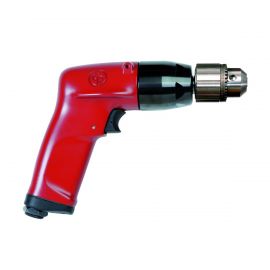Pneumatic Tools VS Electric Power Tools

Pneumatic and electric power tools differ significantly in terms of strength, characteristics, and costs. Engineered with ultra-reliable quality and superior precision, both pneumatic tools and electric tools offer somewhat similar functions with high-performance features to suit various job applications. In this article, we will explore the main differences and comparisons between these two types of power tools. Knowing and understanding the different types of these power tools will help you make a more informed decision when choosing the right tools for your project.
Pneumatic Power Tools
 |
Pneumatic tools, also known as air tools, are powered by compressed air to run the power tools instead of mechanical force. They are reliable power tools that require an air compressor to deliver greater torque and power. Pneumatic tools can be used for a large scale of applications and provide excellent performance when working in heavy-duty applications. There is no doubt that pneumatic tools are more powerful than electric tools since air compressors can produce powerful bursts of energy by compressing and condensing air. The large amount of energy in pneumatic tools makes them extremely powerful, far superior to electric tools when it comes to power. As pneumatic power tools are not equipped with a main motor, they are relatively smaller and lighter than the traditional electric power tools. Pneumatic tools provide greater power-to-weight ratios, which enables smaller, lighter air tools to produce more power than electric tools. |
|
When compared to electric power tools, pneumatic tools offer a greater level of safety. Tested with highest quality and safety standards, certain pneumatic tools are easy to handle and safe to use under hazardous or explosive environments. Pneumatic tools provide high degree of safety as they do not pose a risk of electric shock when encountered with water. Underwater air tools can be used with or around water in a safe manner. Therefore, pneumatic tools are best suited for use in hazardous or explosive environments such as oil refineries. As a final point, pneumatic tools tend to require less maintenance and their parts tend to last longer than electric tools since they contain fewer parts in the machine itself, making them more reliable and cheaper to maintain. Pneumatic tools are generally lighter and easier to handle than electric ones, but they are not as portable because an air compressor machine is required to operate them. It can be a hassle and difficult to carry a compressor around with you when performing simple tasks at jobsite, and maintaining the compressor is a time-consuming task as well. Hence, it may not be convenient to transport to remote work sites. In addition, the initial investment costs of pneumatic tools are higher than electric power tools as users must purchase air compressor machine to run the pneumatic tools. |
Electric Power Tools
 |
Electric power tools are driven by motors that require electricity from either a power cord or battery. The motors are powered by a constant supply of electricity as motive power. Corded and cordless power tools are two types of electric power tools that are widely available and popular in the market. Corded and cordless power tools operate differently. Corded power tools require an extension cord and plug in order to function, while cordless power tools will require a rechargeable battery to be attached to the tools itself to operate. Electric power tools are heavier than pneumatic ones because of the attachment of batteries or their electrical cables. However, electric power tools offer greater portability and versatility as they are operated by electrical cables or batteries without other cumbersome equipment such as an air compressor to power them. Highly portable and versatile, they can be used in both indoor and outdoor environments; therefore, making them easy to set up and transport from one work site to another with ease. |
|
Additionally, as the electric power tools tend to have lower revolutions per minute (RPM), and hence they typically require a longer time to complete a task. Furthermore, electric tools have a shorter life span than pneumatic tools due to common wear and tear on the motors and parts. The batteries in cordless power tools can also run out quickly and wear out over time. Electric tools must be serviced and inspected on a regular basis to ensure proper operation. On a positive note, electric power tools are cheaper than pneumatic tools and require less costs as they do not require additional equipment to operate them. Hence, users must invest in rechargeable batteries for cordless tools or opt for corded electrical versions. |
After exploring the above comparisons, let's summarize them. Pneumatic tools are a safe choice for users as they do not pose an electrical hazard, they are generally cheaper to maintain but the initial set up costs may be higher due to the need for an air compressor. However, if you are concerned about portability and convenience, electric power tools will be your best choice.
Sourcing for high efficiency and reliable power tools for your projects? As a leading and established distributor with over 20 years of experience in Malaysia, IDEMCO SDN BHD has vast experience in distributing and stocking a wide range of high-quality and reliable Pneumatic Tools and Electric Power Tools from renowned brands for a large scale of applications. Browse our website to learn more: www.idemcosb.com.my
Power Tools: bit.ly/3U23LUC
Pneumatic Tools: bit.ly/3UVyKDh
Get in touch with us and let us know how we can assist you with your pneumatic tools and power tools requirement. >> idemco@idemcosb.com.my
 737
737







